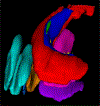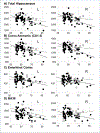Medial temporal lobe volumes in late-life depression: effects of age and vascular risk factors
- PMID: 30251182
- PMCID: PMC6431585
- DOI: 10.1007/s11682-018-9969-y
Medial temporal lobe volumes in late-life depression: effects of age and vascular risk factors
Abstract
Substantial work associates late-life depression with hippocampal pathology. However, there is less information about differences in hippocampal subfields and other connected temporal lobe regions and how these regions may be influenced by vascular factors. Individuals aged 60 years or older with and without a DSM-IV diagnosis of Major Depressive Disorder completed clinical assessments and 3 T cranial MRI using a protocol allowing for automated measurement of medial temporal lobe subfield volumes. A subset also completed pseudo-continuous arterial spin labeling, allowing for the measurement of hippocampal cerebral blood flow. In 59 depressed and 21 never-depressed elders (mean age = 66.4 years, SD = 5.8y, range 60-86y), the depressed group did not exhibit statistically significant volumetric differences for the total hippocampus or hippocampal subfields but did exhibit significantly smaller volumes of the perirhinal cortex, specifically in the BA36 region. Additionally, age had a greater effect in the depressed group on volumes of the cornu ammonis, entorhinal cortex, and BA36 region. Finally, both clinical and radiological markers of vascular risk were associated with smaller BA36 volumes, while reduced hippocampal blood flow was associated with smaller hippocampal and cornu ammonis volumes. In conclusion, while we did not observe group differences in hippocampal regions, we observed group differences and an effect of vascular pathology on the BA36 region, part of the perirhinal cortex. This is a critical region exhibiting atrophy in prodromal Alzheimer's disease. Moreover, the observed greater effect of age in the depressed groups is concordant with past longitudinal studies reporting greater hippocampal atrophy in late-life depression.
Keywords: Depressive disorder; Geriatric; Hippocampus; MRI; Perirhinal cortex; Structural.
Conflict of interest statement
Conflict of Interest: The authors deny any conflicts of interest and have no disclosures to report.
Conflict of Interest: All authors (Taylor, Deng, Boyd, Donahue, Albert, McHugo, Gandelman, Landman) deny any conflict of interest.
Figures


Similar articles
-
Anterior-posterior gradient differences in lobar and cingulate cortex cerebral blood flow in late-life depression.J Psychiatr Res. 2018 Feb;97:1-7. doi: 10.1016/j.jpsychires.2017.11.005. Epub 2017 Nov 11. J Psychiatr Res. 2018. PMID: 29156413 Free PMC article.
-
Major depressive episodes over the course of 7 years and hippocampal subfield volumes at 7 tesla MRI: the PREDICT-MR study.J Affect Disord. 2015 Apr 1;175:1-7. doi: 10.1016/j.jad.2014.12.052. Epub 2014 Dec 30. J Affect Disord. 2015. PMID: 25589378
-
Hippocampus atrophy and the longitudinal course of late-life depression.Am J Geriatr Psychiatry. 2014 Dec;22(12):1504-12. doi: 10.1016/j.jagp.2013.11.004. Epub 2013 Nov 22. Am J Geriatr Psychiatry. 2014. PMID: 24378256 Free PMC article.
-
Subgenual anterior cingulate cortex and hippocampal volumes in depressed youth: The role of comorbidity and age.J Affect Disord. 2016 Jan 15;190:726-732. doi: 10.1016/j.jad.2015.10.064. Epub 2015 Nov 12. J Affect Disord. 2016. PMID: 26600415 Review.
-
Medial Temporal Lobe Anatomy.Neuroimaging Clin N Am. 2022 Aug;32(3):475-489. doi: 10.1016/j.nic.2022.04.012. Neuroimaging Clin N Am. 2022. PMID: 35843657 Review.
Cited by
-
The enigma of vascular depression in old age: a critical update.J Neural Transm (Vienna). 2022 Aug;129(8):961-976. doi: 10.1007/s00702-022-02521-5. Epub 2022 Jun 15. J Neural Transm (Vienna). 2022. PMID: 35705878 Review.
-
Temporal lobe dysfunction for comorbid depressive symptoms in postherpetic neuralgia patients.Brain Commun. 2025 Apr 2;7(2):fcaf132. doi: 10.1093/braincomms/fcaf132. eCollection 2025. Brain Commun. 2025. PMID: 40226379 Free PMC article.
-
Psychosocial factors and hippocampal subfields: The Medea-7T study.Hum Brain Mapp. 2023 Apr 1;44(5):1964-1984. doi: 10.1002/hbm.26185. Epub 2022 Dec 30. Hum Brain Mapp. 2023. PMID: 36583397 Free PMC article.
-
Cognitive phenotypes in late-life depression.Int Psychogeriatr. 2023 Apr;35(4):193-205. doi: 10.1017/S1041610222000515. Epub 2022 Jun 29. Int Psychogeriatr. 2023. PMID: 35766159 Free PMC article.
-
Associations of AT(N) biomarkers with neuropsychiatric symptoms in preclinical Alzheimer's disease and cognitively unimpaired individuals.Transl Neurodegener. 2021 Mar 31;10(1):11. doi: 10.1186/s40035-021-00236-3. Transl Neurodegener. 2021. PMID: 33789730 Free PMC article. Review.
References
-
- Binnewijzend MA, Kuijer JP, Benedictus MR, van der Flier WM, Wink AM, Wattjes MP et al. (2013). Cerebral blood flow measured with 3D pseudocontinuous arterial spin-labeling MR imaging in Alzheimer disease and mild cognitive impairment: a marker for disease severity. Radiology, 267(1), 221–230. - PubMed
-
- Braak H, Braak E (1991). Neuropathological Staging of Alzheimer-Related Changes. Acta Neuropathol, 82(4), 239–259. - PubMed
MeSH terms
Grants and funding
LinkOut - more resources
Full Text Sources
Other Literature Sources
Medical
Miscellaneous

